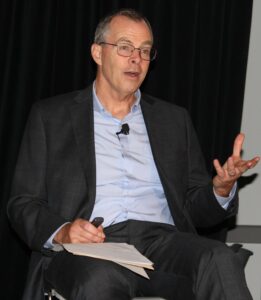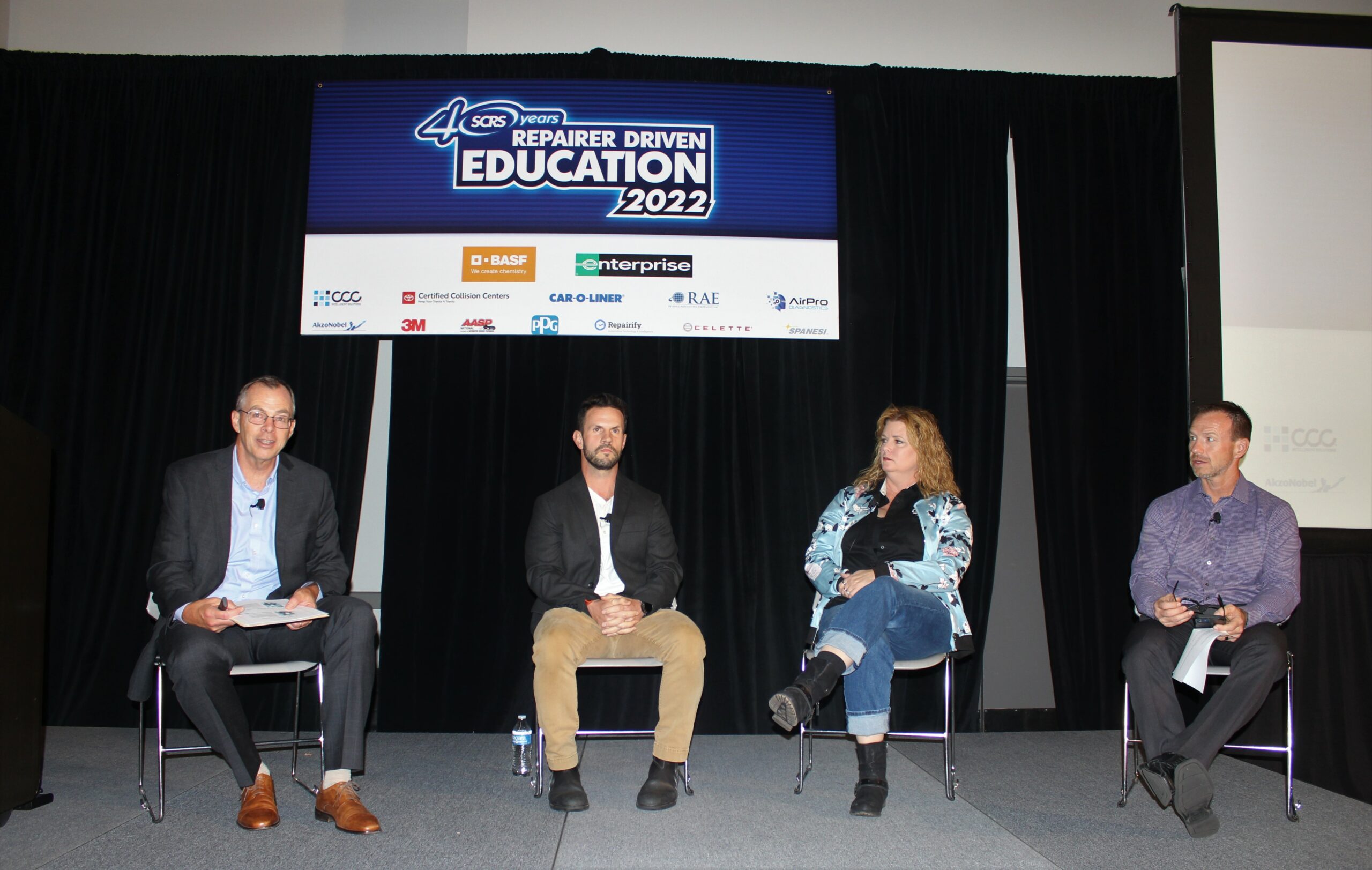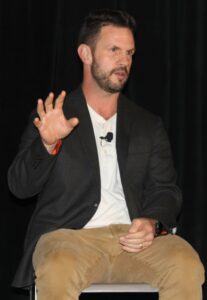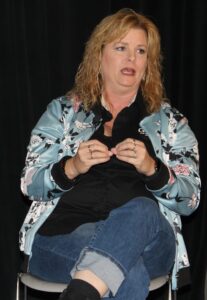
Tips on how to mitigate liability risks at your shop
By onBusiness Practices | Collision Repair
Two shop owners and SPARK Underwriters staff discussed last week best practices for collision repair shops to follow to mitigate insurance and legal risks while also properly and safely repairing customer vehicles.
The panel discussion was held during the 2022 SEMA Show in Las Vegas as part of the annual slate of Repairer Driven Education (RDE) sessions held by the Society of Collision Repair Specialists (SCRS).
Mundy’s Collision owner Jason Mundy and Richie’s Collision Center owner Tracy Lewis sat down with SPARK Underwriters Chief Underwriting Officer David Willett and Vehicle Specialty Market Underwriter Shaughn Kennedy to discuss some of the top concerns they face in running their businesses. Both mentioned their concern over whether sublet vendors are actually completing proper advanced driver assistance system (ADAS) calibrations to OEM specifications and the liability it puts on their shops if they don’t, or if they do and don’t document them.
Keeping up with updated OEM repair procedures, protecting customers’ personally identifiable information (PII) on total loss vehicles, having proper electric vehicle (EV) tools, equipment, and training, and vehicle photo estimating were also covered.
Mundy shared an example of how trusting vendors to complete calibrations without double-checking their work can prove costly and dangerous. A close friend of his who owns a collision repair shop completed repairs on a vehicle and then sent it to a dealership to have the blind spot monitor he replaced calibrated. Two weeks later, the owner sideswiped another vehicle because her blind spot monitor didn’t work correctly.
“We can all say, ‘Well, you know, you really shouldn’t have pinned it on that,'” Mundy said. “But I think the more ADAS that we experience, the more we kind of rely on it. I mean, backing up not using a camera just feels so weird. …you start to rely on these features.”
It turns out, he said, the blind spot monitor wasn’t calibrated or programmed, and by proving that, the dealership paid for the repairs.
“He [Mundy’s friend] admittedly said, ‘What I should have done is test driven the vehicle when I got it back from the dealer.’ …You have to be very aware of what is the [OEM] procedure? How do I verify the procedure’s been done?”
Kennedy added that from a business insurer’s standpoint, shop owners need to always make sure their vendors have a certificate of insurance and carry at least liability insurance.
“In this case, had the dealer not paid that, a good insurance carrier is probably going to pursue a claim against that dealer,” he said, while liability insurance would typically be the primary coverage of sublet vendor work.
Willett said shops should even take it a step further and use certificate tracking software to ensure vendor insurance coverages are up-to-date, especially for shops that use several vendors.
“Just because they have insurance doesn’t mean they have it at all times,” he said. “Their insurance can run out or it can get canceled at times or lowered, or changed or altered. And so it may sound ridiculous but this is something that your insurance provider should be very knowledgeable about and be able to help you administer a certificate tracking to make sure that you do have a backstop to put it through.”
Willett also recommends having an auditing process to check out every fifth or 10th vehicle, for example, that was calibrated by a vendor. He noted it likely wouldn’t be an efficient use of shop time to check every vehicle. However, the liability of a future collision or malfunction — just as with any repair that a collision shop makes — always falls back on the shop, not the vendors.
“You don’t know whether or not they’re doing the job right,” Lewis said. “You’re putting your customers’ lives back in that car and telling your customers, ‘We’ve signed off on this. Everything’s good. You’re safe now.’ …For us as a shop, and in part of our growth too, [we’re] just trying to figure out how much of that can we keep in-house so that we can properly train somebody and we know it’s done right.”
Because of that risk, Mundy’s shop brought their calibrations in-house, which he said is “a huge profit center” and a “win-win” because it ensures the calibrations are done properly.
“If you’re subletting something out and you don’t know the procedure then kind of shame on you because you get that vehicle back and you don’t ask the dealer or a mobile guy, ‘Did you do these procedures?’ Then they probably didn’t do them,” he said.
Keeping Up with OEM Repair Procedures and Protecting Data
The panel noted, as OEMs themselves have also emphasized, that procedures need to be researched and documented for every vehicle every time it comes in.
“Every vehicle that comes in [that] we write a repair plan on, we document the repair procedures that were performed at that time so they’re timestamped,” Mundy said. “If those procedures changed in the future or past that vehicle being repaired, we’d still have a timestamp. …It’s evolving so quickly you have to do those procedures, even if you’re doing the same make that could change throughout that year. It’s very important to protect yourself by pulling the vehicle in and doing that OEM research for that specific vehicle.”
Kennedy said Mundy is doing everything right from a risk standpoint but he’s handled plenty of claims where shops haven’t.
“I’ve handled many claims where we have to go back and examine the work of the shop and the first thing I ask them is, ‘Okay, what’d you do to repair it?’ And unfortunately, there’s a lot of shops out there, mechanical or collision, [that say], ‘Like always, follow the procedures,'” he said. “I’m like, ‘Well, do you have them?’ And they’re like, ‘Oh, no. You can look them up in ALLDATA.’ Well, unfortunately, five years ago, the repair process in ALLDATA was different and that’s not preserved anywhere. …By capturing that and documenting that in the repair plan, it really helps build a bulletproof case that you followed the repair procedures.”
And, Kennedy continued, it’s OK for shops to know their limits.
“I think that’s the biggest struggle I see people get into is they try to do too much. Sometimes you need to know what you’re good at and do the thing you’re good at the best you can do it. If you want to try to repair everything out there, that’s a lot of commitment. Usually, that’s more commitment than what people have capabilities for. Because now, in today’s world, when you hire somebody specifically… to pull repair procedures, that tells you the commitment that goes into it.”
Another concern discussed is what shops should do when billpayers push back on paying for proper OEM repairs.
“We’ve started to have that upfront conversation: ‘Your insurance company may not pay you to repair your car properly, so just be prepared to go to battle with us or know that you may be a couple hundred bucks out of pocket to repair it properly,'” Mundy said.
Lewis compared the battle to auto insurance coverage becoming more like medical insurance.
“You have a deductible. The insurance company pays what they’re gonna pay, and then you have the responsibility for the rest,” she said. “I’ve had insurance companies say…, ‘Well, we’re not saying don’t do it, we’re just saying we’re not gonna pay for it.’ …It goes back to when you know what the right thing to do [is] and you don’t do it but we also know we cannot foot that bill to repair people’s cars. So, we’ve had to have a lot of come-to-Jesus meetings on a lot of things.”
It’s incumbent on business insurance carriers as well to work with shops on business practices to follow to mitigate shops having to foot the bill to follow OEM repair procedures when insurers refuse to pay for them, such as by holding them to legal statutes and policy contracts, Willett said.
As for customer data protection, Lewis said her shop treats it not only as a service to their customers but as a way to make a little extra money on total loss vehicles.
“Every time somebody plugs into a car [with] their phone that puts that phone and all that information in the car… even a rental car,” she said. “And it stores that information. …charge an hour, use the OEM manual and you can delete that customer’s data. You’re not deleting anything [crash data] off of a car so if they ever have to go back and investigate from an accident, it’s not deleting any of that data. It’s just deleting that person’s personal information.”
EVs: Equipment, training, and fire risk
The panel went on to discuss fire risks associated with EVs, including recent cases of the vehicle type that were damaged from floodwaters spontaneously combusting days later. Both shop owners said they’re in the preparation phase of learning how to handle EVs.
“They’re [EVs] obviously coming. Everyone has their own platform,” Mundy said. “All of our manufacturers have their own platform. …We’re just kind of getting prepared. We’re very unfamiliar with EV territory. That’s a concern. …We’re set up pretty well as far as precautions, as far as a fire in the paint booth or a fire in the shop or a fire in the office — how to mitigate that but once we start really bringing in those EVs, we’ll have to make some other accommodations. It’s ever-evolving.”
Lewis noted that specialized fire extinguishers or granules are needed to extinguish an EV fire and that applies to hybrid vehicles too, which are also lithium fires and can’t be put out with water, she said. Keep in mind, however, that fire response can vary by OEM so be sure to refer to OEM emergency response guides (ERGs) to find vehicle-specific information for fighting high-voltage lithium-ion battery fires including de-energizing vehicles, avoiding thermal runaway, and when the use of water to extinguish fires is correct.
When it comes to EVs, it’s also crucial to keep in-date proper PPE as well as the correct equipment for fire suppression and moving EVs around, Willett said. OEMs include in their repair procedures the proper ways to move their EVs, which can specify a forklift or dollies.
“We’re recommending our shops that do towing stay away from doing EVs at this point unless they really, really got it nailed,” Willett said. “It’s just the exposure we believe is too great for what they’re gonna earn on that job.”
Photo Estimates
Mundy and Lewis expressed their frustration with artificial intelligence (AI) based photo estimating through mobile apps that insurers tell their customers to use.
“When they do download those apps and we get a $1,200 estimate, it turns into $12,000,” Mundy said, meaning they’re not accurate to what repairers can see in person. “That really prolongs the process. If you were to get a good estimate upfront you’d have that one supplement, that one repair plan and get it done rather than reconcile it and wait on that to come back.”
Lewis pointed out that it can take two to three weeks to hear back from the insurance company on the initial photo estimate.
“Then you send in a $8,000 supplement on it and they’re like, ‘Oh my gosh, that’s so many red flags,'” she said. “Then you’re having to be required to make sure you take the proper pictures and make sure you document everything … and they’re like, ‘That’s not a good enough picture.’ It prolongs those things. …A lot of times, that’s people sitting behind a desk who have not actually been trained. They don’t physically go look at cars. They’ve never worked in the automotive business. That’s such a headache because then you’re trying to explain to them and they’re like, ‘What’s a pinch weld?'”
She offered a potential solution that her shop offers — mobile estimating. Richie’s decided to offer the service because of their rural location where they’re not the easiest for customers to find and to better serve potential customers that are elderly who don’t know how to use the apps that insurance companies want them to use to file claims.
“We go to them and, if nothing else, we capture that person,” she said. “We capture that customer and even if their car totals, we’ve got that customer because we took that time to go do that. …[It’s also] a way of getting around those bad shots that somebody else takes and somebody gives you some estimate they want to repair the car from that.”
Willett added that business insurers can, and should, step in to help shops that are met with those types of estimate issues.
“When you’re doing a repair, you’re supposed to do it right and when you’re doing the insurance, you’re supposed to do it right,” he said. “They should be able to step in and… talk to a billpayer.”
Lewis added, “We are the experts in the field. We have to be the ones to fight on behalf of our customers and our shop, for liability reasons and moral reasons, to repair these cars properly. We can’t rely on the insurance companies to tell us how to do it because they don’t take I-CAR classes. They don’t take training classes and frame classes and welding classes. …We have to know what we’re talking about because that gives us validity and it also gives us protection for our customers.”
Images
Featured image: SPARK Underwriters Chief Underwriting Officer David Willett (Lurah Lowery/Repairer Driven News)
Willett, Mundy’s Collision owner Jason Mundy, Richie’s Collision Center owner Tracy Lewis, and SPARK Underwriters Vehicle Specialty Market Underwriter Shaughn Kennedy. (Lurah Lowery/Repairer Driven News)



